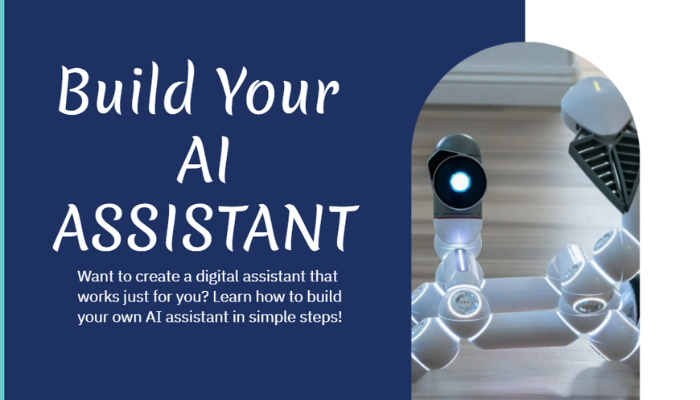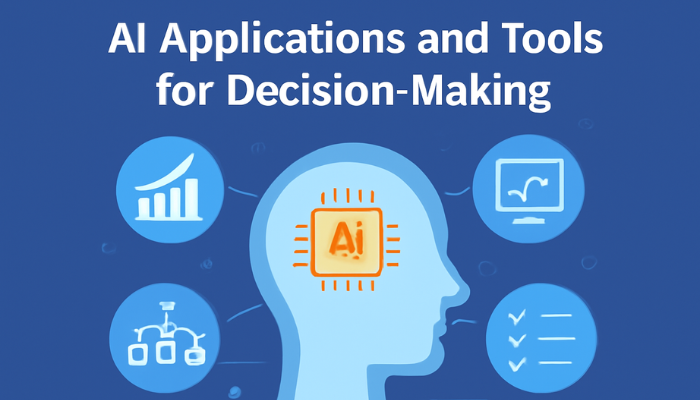What if the next step in personal productivity isn’t a new app or gadget, but creating an assistant that works just for you? Imagine having an AI that learns your preferences, adapts to your routines, and takes care of all the repetitive tasks you’d rather avoid.
AI assistants have already become a huge part of our everyday lives. In fact, over 8.4 billion digital voice assistants were active worldwide, which is more than the entire global population! And it’s not just in our personal lives—by 2028, 75% of enterprise software engineers in developed countries are expected to be using at least one AI code assistant, according to Gartner.
Creating your own AI assistant might sound like a futuristic idea, but it’s actually more accessible than you’d think. With the right tools, you can build a personalized assistant to help you stay organized, automate tasks, and even enhance customer interactions.
Let’s walk through how you can create your own, in just a few simple steps.
What Are AI Assistants?
AI assistants are like digital helpers that use artificial intelligence to understand and perform tasks for you. They’re powered by technologies like Natural Language Processing (NLP) and Machine Learning, which allow them to understand human language and learn from interactions to get better over time.
In business, AI assistants can help automate tasks like scheduling meetings, managing customer queries, sending reminders, and handling administrative work. This helps your team save time and focus on more important tasks. Many businesses are already using AI assistants to improve workflows, boost customer service, and increase efficiency.
In short, AI assistants are changing the way businesses work by taking care of repetitive tasks, improving productivity, and offering personalized support to both employees and customers.
Also Read: Agentic AI vs RAG: Comprehensive Comparison Guide
Now, let’s explore the different types of AI assistants and how each one can make a real impact on your business or personal tasks.
Types of AI Assistants
AI assistants come in different forms, each designed to handle specific tasks and enhance productivity. Here’s a quick overview:
Customer Support Assistants
Used by businesses to automate customer service, these AI assistants can chat with customers, answer their questions, and even resolve basic issues. They use Natural Language Processing to understand and respond to customer inquiries, often handling everything from FAQs to troubleshooting steps.
Enterprise Assistants
These are built for business environments, helping employees by automating workflows, scheduling meetings, or even managing company data. Examples include AI assistants in CRM (Customer Relationship Management) systems or project management tools. They help businesses stay organized and improve efficiency across teams.
Workflow Automation Assistants
These AI assistants help automate repetitive tasks such as scheduling, task management, and data entry. They are integrated with business systems like CRM or ERP tools, streamlining internal workflows. For example, AI assistants in Microsoft 365 help automate calendar scheduling, document management, and other administrative tasks.
Sales Assistants
Sales-focused AI assistants help with lead generation, qualifying prospects, and even nurturing leads by automating outreach tasks like follow-up emails and scheduling. These assistants are integrated with CRM systems like Salesforce or HubSpot to assist sales teams in reaching their targets faster.
HR and Employee Support Assistants
These AI assistants are integrated into HR platforms to handle routine employee inquiries, manage leave requests, and even assist with payroll-related questions. Tools like Workday and Zoho People incorporate AI assistants to streamline HR tasks and improve employee experience.
Onboarding Assistants
AI assistants are used in onboarding processes to guide new employees through their training, provide necessary documentation, and help them integrate into the company more efficiently. These assistants are integrated into internal communication platforms or employee portals.
Ready to Create Your AI Assistant?
Don’t wait—Codewave can help you build the perfect AI assistant today.
Contact us and let’s make automation work for you!
Now, you might be wondering, how do you actually create your own AI assistant? It’s not as complicated as it sounds. Let’s walk through the simple steps you need to follow to build an AI assistant that fits your needs perfectly.
Steps to Build Your AI Assistant
Building your own AI assistant doesn’t have to be complicated! Follow these simple steps, and you’ll be on your way to creating a smart, helpful assistant tailored to your needs:
1. Define Your Assistant’s Purpose
Before you jump into the technical side, take a step back and think about what you need your AI assistant to do. Is it going to handle customer inquiries, automate your schedule, or manage specific tasks like inventory tracking? Defining your assistant’s purpose will help you tailor its features and ensure it’s focused on solving your specific problem.
This is the foundation of everything that follows.
- What problem do you want to solve? Are you overwhelmed with scheduling or handling repetitive tasks? An AI assistant can take those off your plate and give you back your time.
- How can it make your life easier? Do you want it to handle customer inquiries, automate your to-do list, or help with more complex tasks like managing inventory or business data?
- What tasks do you wish could be automated? What takes up too much of your time? Is it answering the same questions over and over again or managing daily operations that could be simplified?
- What would make you more productive or organized? Would a personal assistant to manage your calendar or a business assistant to streamline customer service help you stay on top of things?
- What impact do you want your assistant to have? Are you looking to improve efficiency, enhance customer experience, or free up more time for creative tasks?
Tip: Start by listing the tasks you wish to automate or improve. This will shape the entire development process.
2. Choose the Right Tools and Technologies
Once you’ve defined what your assistant will do, it’s time to choose the tools and technologies that will bring it to life. For most AI assistants, you’ll need:
- Natural Language Processing (NLP): This helps your assistant understand and generate human language. Popular NLP frameworks include Google’s Dialogflow and Rasa.
- Machine Learning: If you want your assistant to learn from interactions, use platforms like TensorFlow or PyTorch.
- APIs: APIs connect your assistant to other platforms or services (think Google Calendar, CRM systems, or Slack).
- Programming Languages: The choice of programming language depends on your project’s requirements and your expertise:
- Python: Widely used for AI and machine learning, Python is known for its simplicity and powerful libraries such as TensorFlow, PyTorch, NLTK, and spaCy. It’s ideal for NLP, machine learning, and speech processing tasks.
- JavaScript: Best suited for building web-based AI assistants with real-time user interactions. Libraries like Node.js, React, and Botpress are great choices for front-end and server-side functionality.
- Other Languages: Java, ideal for enterprise-grade applications and large-scale solutions. C++ is perfect for performance-critical tasks like voice recognition engines where speed is essential.
- Tip: Choose frameworks and tools that align with your level of expertise and your assistant’s specific needs.
3. Design the User Interface
A great AI assistant isn’t just about backend performance—it needs to be user-friendly. The user interface (UI) is where the magic happens, whether it’s a chatbot, voice assistant, or a combination of both.
- Text-Based Interface: Chatbots or messaging apps like Slack and Facebook Messenger are common platforms for text-based assistants.
- Voice-Based Interface: If you want a more interactive experience, consider integrating voice recognition tools like Google Assistant SDK or Amazon Alexa.
- Multi-Platform: Your assistant should ideally work across different platforms (website, mobile app, etc.) to reach your audience where they are.
- Tip: Keep the interface simple, clear, and intuitive. The goal is for users to interact naturally with your assistant.
4. Develop Core Functionalities
This is where the real magic happens—creating the features that will allow your assistant to do its job. For example:
- Task Automation: Write scripts that allow the assistant to perform specific tasks (e.g., schedule meetings, send emails, or make recommendations).
- Learning Capabilities: Implement machine learning algorithms that enable your assistant to adapt and improve over time, such as by personalizing responses based on previous interactions.
- Third-Party Integrations: Your assistant should connect with external tools, such as email services, CRM systems, or databases, using APIs.
- Tip: Start small with core functionalities. You can always expand its capabilities as you go.
5. Train Your AI Assistant
AI assistants need training to understand language and improve their performance. Training involves feeding your assistant examples (known as training data) so it can learn how to respond appropriately.
- NLP Training: If you’re building a text or voice-based assistant, you’ll need to train it on common phrases, questions, and responses.
- Machine Learning: To improve its decision-making abilities, you may need to train your assistant using historical data, customer interactions, or even simulated environments.
- Tip: Continuously train your assistant with real user data to improve accuracy and responsiveness over time.
6. Test and Iterate
Once your AI assistant is up and running, it’s time to test it. Testing helps you identify bugs, fix any errors, and improve functionality before launching it to users.
- User Testing: Have real people interact with your assistant to get feedback on usability and performance.
- Iterative Improvement: Based on the feedback, tweak your assistant’s responses, improve its understanding, and optimize its features for better performance.
- Tip: Testing should be an ongoing process. The more you test, the more you’ll improve your AI assistant.
7. Deploy and Monitor
Once you’ve tested and refined your AI assistant, it’s time to go live. Deploying your assistant means making it available to your users, either via a website, app, or as a stand-alone service.
- Deployment Platforms: Consider cloud platforms like AWS, Google Cloud, or Azure for easy deployment and scalability.
- Monitoring and Maintenance: Even after deployment, you’ll need to monitor your assistant’s performance and make necessary updates. Tools like Prometheus or Grafana can help you keep track of system health.
- Tip: Keep an eye on your AI’s performance after launch and make improvements based on real-world usage.
Building your own AI assistant is just the beginning. To truly get the most out of it, continuous improvement is key.
Let’s explore how you can enhance your custom AI assistant, making it smarter, more efficient, and better suited to your needs over time.
How to Improve Your Custom AI Assistant
Building your own AI assistant is an exciting first step, but to make it truly effective, you’ll need to constantly refine and improve it. Here are a few strategies to enhance your AI assistant’s performance and keep it evolving:
1. Continuously Train Your AI
AI systems get smarter with more data. As your assistant interacts with users, it collects valuable feedback that can be used to improve its responses and decision-making. Make sure to:
- Update Training Data: Regularly update your assistant’s training data with new examples, phrases, and user interactions.
- Use Real-World Feedback: Monitor how your assistant is used and adjust its learning algorithm based on real user feedback.
2. Improve Natural Language Understanding (NLU)
If your AI assistant interacts through text or voice, improving its Natural Language Understanding (NLU) is critical for delivering accurate responses. Here’s how to fine-tune its NLU:
- Expand Vocabulary: Add new words, slang, and industry-specific terms to its vocabulary to improve understanding.
- Context Awareness: Train your assistant to better understand the context of conversations and respond more naturally.
3. Monitor and Optimize Performance
The more your AI assistant is used, the more data it collects about its performance. By monitoring how it operates, you can pinpoint areas for improvement:
- Track Key Metrics: Measure response accuracy, response time, and task completion rate.
- Identify Bottlenecks: Look for tasks where the assistant struggles or fails to meet expectations, and focus on improving those areas.
The more personalized your assistant, the more valuable it becomes to the user. Here’s how to tailor it to individual needs:
- User Profiles: Create user profiles so the assistant can remember preferences, previous interactions, and specific needs.
- Behavioral Adaptation: Allow your assistant to learn and adapt to a user’s behavior, providing more relevant responses as time goes on.
5. Integrate More Advanced AI Technologies
As AI evolves, so should your assistant. Stay updated with the latest technologies and integrate advanced capabilities to make your assistant more powerful:
- Machine Learning: Introduce advanced machine learning models to improve decision-making and predictive capabilities.
- Voice Recognition: Enhance voice-based interactions with more accurate voice recognition tools and context-sensitive listening.
6. Expand its Capabilities
Don’t limit your assistant to just one function—expand its capabilities as your business or needs grow. You can add new tasks or integrate it with other platforms:
- API Integrations: Connect your assistant with other tools and platforms for seamless workflows (e.g., integrating with your CRM or email marketing software).
- Multitasking: Allow your assistant to handle multiple tasks at once, improving efficiency and saving time.
7. Gather Ongoing Feedback
Feedback is a goldmine for improvement. Keep collecting feedback from users and analyze it to make necessary changes. Here’s how:
- Surveys and Ratings: Use surveys or rating systems to gather direct feedback from users about their experience.
- User Testing: Conduct regular user testing to identify any pain points and areas for improvement.
You’ve got the steps to improve your AI assistant, now let’s talk about what it’ll actually cost to bring it to life. Building a smart, reliable assistant doesn’t have to break the bank, but understanding the costs up front is key.
Let’s break it down!
Cost Breakdown of AI Assistant Development
| Cost Category | Description | Estimated Cost |
| Development Tools | Includes software, platforms, and frameworks to build the AI assistant (e.g., APIs, NLP tools, ML libraries). | Free (open-source options) to $500+/month for enterprise-level tools |
| Hosting & Infrastructure | The cost of cloud hosting, server infrastructure, and storage for running the AI assistant. | $5 – $50/month (depending on scale and service provider) |
| Integration Costs | Costs related to integrating the AI assistant with existing business systems (e.g., CRM, ERP). | $100 – $1,000+ depending on complexity and number of integrations |
| Training & Data | The cost of collecting, labeling, and feeding data into the AI system for training purposes. | $500 – $3,000+ depending on data quality and amount |
| Maintenance & Support | Ongoing costs for bug fixes, updates, and system optimization to keep the assistant running smoothly. | $100 – $1,000/month for ongoing support and updates |
| Customization | Customizing the AI assistant to meet specific business needs, including additional features and user interface design. | $1,000 – $10,000+ for full customization |
| Security & Privacy | Implementing security measures and ensuring compliance with regulations (e.g., GDPR). | $500 – $5,000 for securing user data and maintaining compliance |
Building an AI assistant involves both one-time setup costs and ongoing expenses. While open-source frameworks can keep initial costs low, other aspects such as hosting, integrations, and customization can add up.
A well-designed AI assistant, however, can quickly prove its value by automating tasks, improving efficiency, and enhancing customer experiences.
Build Your AI Assistant With Codewave
Building your own AI assistant is an exciting prospect, but it requires the right expertise to truly create something impactful. At Codewave, we specialize in developing Agentic AI products that do more than just assist—they transform your business operations and customer interactions.
With Agentic AI, Codewave goes beyond basic task automation. Our solutions are designed to optimize workflows, boost customer engagement, and provide actionable insights. By leveraging Next-gen technologies like Natural Language Processing (NLP), Machine Learning (ML), and Reinforcement Learning (RL), we build AI assistants that not only perform tasks but also learn, adapt, and evolve to meet your unique needs.
We solve key challenges such as automating repetitive tasks, personalizing user experiences, and scaling business operations efficiently. The outcomes? Increased productivity, better customer service, and data-driven decision-making.
Technologies we use:
- TensorFlow for deep learning models that power decision-making and adaptability.
- PyTorch for flexible neural networks that drive learning and predictions.
- Rasa for open-source, customizable NLP solutions.
- AWS for scalable cloud infrastructure, ensuring your AI assistant can grow with your business.
We combine our technical expertise with a deep understanding of business needs, ensuring that your Agentic AI assistant delivers long-term value without compromising on quality or cost.
Let’s work together to build an AI assistant that transforms the way you work and interact with customers.
Save 20+ hours/week with an AI assistant—book a free strategy call!
Codewave is a UX first design thinking & digital transformation services company, designing & engineering innovative mobile apps, cloud, & edge solutions.







